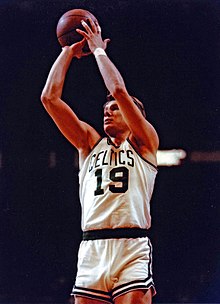Don Nelson
After an All-American career at the University of Iowa, Nelson won five NBA championships playing with the Boston Celtics, with his number 19 retired by the franchise in 1978.
A coaching innovator, Nelson is credited with, among other things, pioneering the concept of the point forward, a tactic which is frequently employed by teams at every level today.
The Nelsons lived in downtown Rock Island on 19th street and Don would walk to school, stopping to shoot baskets at several different locations along the way.
[11] In the era when NCAA freshman weren't allowed to play varsity, Nelson was joined on the Iowa campus by future Hall of Famer Connie Hawkins in 1960.
[21][22][23] After two seasons with the Lakers, where he averaged 4.3 points and 3.3 rebounds in 13 minutes playing alongside Hall of Famers Elgin Baylor and Jerry West, Nelson left Los Angeles.
[22][18] In his first season with Boston and coach Red Auerbach, Nelson averaged 10.2 points and 5.4 rebounds, helping the Celtics to the 1966 NBA Championship over the Lakers.
Nelson joined Russell, Havlicek, Bailey Howell, Sam Jones, Sanders and Siegfried in double digit scoring.
In Game 7 of the 1969 NBA Finals, against his former team, Nelson converted one of the most famous shots in playoff history—a foul-line jumper which dropped through the basket after hitting the back rim and bouncing several feet straight up.
He would place the ball in his shooting hand, lean in almost off-balance and toe the free-throw line with his right foot and his left leg trailing.
[18] After his career ended, Nelson's son Donnie remembers the family sitting in a Maid Rite restaurant in Moline, Illinois, and Don saying he had three choices: sell cars, become an NBA referee, or accept an assistant's job under Milwaukee coach Larry Costello.
Nelson made his first trade in 1977 by sending Swen Nater to the Buffalo Braves and turned the draft pick he received into Marques Johnson, who had a solid career with the Bucks.
Perhaps his most publicized deal came before the 1984–85 season when he dealt Johnson, Junior Bridgeman, Harvey Catchings, and cash to the San Diego Clippers for Terry Cummings, Craig Hodges, and Ricky Pierce.
[36] This enabled Nelson to field shooting guards Sidney Moncrief and Craig Hodges or Ricky Pierce at the same time without worrying about who would run the offense.
This system, known as "Nellie Ball", created a lot of mismatches and enabled Nelson to lead the Bucks to seven straight Central Division championships with over 50 wins in each of those seasons.
For seven straight years, finishing no worse than second best in the Eastern Conference, the Bucks ended up being eliminated in the playoffs by either the Larry Bird-led Boston Celtics or the Julius Erving-led Philadelphia 76ers.
After the 1986–87 season, which included some controversy and distraction before Game 4 of the 1987 Eastern Conference Semifinals against the Boston Celtics where Nelson told the local sports media that he didn't expect to be back once the season concluded due to a rift with Bucks owner Herb Kohl,[37] On May 27, 1987, Nelson resigned as head coach of the Bucks.
Nelson decided to go with Golden State, at first buying a minority stake in the team[39] before being named head coach and vice president after one season away from the NBA.
Again using an unconventional lineup which featured three guards (Mitch Richmond, Tim Hardaway and Sarunas Marciulionis) and two forwards (Chris Mullin and the 6'8" Rod Higgins at center), he coached the Warriors to a 23-game turnaround of their previous season and back into the playoffs with his lineup popularly known as Run TMC, for Tim, Mitch and Chris.
Despite Webber averaging 17.5 points and 9.1 rebounds per game and winning the 1994 NBA Rookie of the Year Award, he found himself at odds with Nelson's preference to play him at center rather than power forward.
Nelson reportedly offered to resign rather than let the team trade away their young star, but nonetheless Webber was dealt to the Washington Bullets on November 7, 1994, for Tom Gugliotta and three future 1st round draft picks (1996, 1998 and 2000).
[42][43] Coached by Nelson, along with assistants Don Chaney, Pete Gillen, and Rick Majerus, Team USA had a roster of Derrick Coleman, Joe Dumars, Tim Hardaway (injured), Kevin Johnson, Larry Johnson, Shawn Kemp, Dan Majerle, Reggie Miller, Alonzo Mourning, Shaquille O'Neal, Mark Price, Steve Smith, Isiah Thomas (injured), and Dominique Wilkins.
[48] Nelson also suggested the Knicks trade Patrick Ewing and a position to make an offer to Shaquille O'Neal, who was rumored to be interested in a move to New York.
Lacking an interior presence to combat low-post players such as Shaquille O'Neal, Nelson introduced the "Hack-a-Shaq" defense to the NBA while in Dallas.
Nelson's style of coaching favored the play of Baron Davis, Monta Ellis, Matt Barnes, Jason Richardson, and Andris Biedriņš.
Midway through the season, Mullin (at behest of Nelson) orchestrated a trade with the Pacers to obtain Al Harrington and Stephen Jackson.
In one of the biggest upsets in NBA playoff history, Nelson coached the 8th-seeded Warriors to series victory over the top-seeded Mavericks in six games.
[58] The San Francisco Chronicle reported that new owners Joe Lacob and Peter Guber wanted "a young, up-and-coming coach" to help revive the Warriors' fortunes.
Nelson defeated the Minnesota Timberwolves on April 7, 2010, achieving his 1,333rd career win and passing Lenny Wilkens for first all-time on the list of the NBA's winningest coaches.
The idea originated from Wisconsin dairy farmer Clarence Willcome, to whom Nelson donated his $11,000 1986 NBA Playoffs bonus compensation.
When Nelson called the university, after being inspired by Shaquille O'Neal to finish his degree, Iowa decided that his lifetime of teaching through NBA coaching would fulfill that requirement and invited him to the graduation ceremony in 2012.




